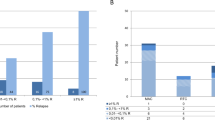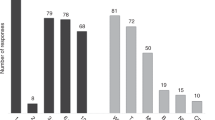Abstract
It still remains unclear whether patients with mixed hematopoietic chimerism (MC) after allogeneic bone marrow transplantation (allo-BMT) have an increased risk of developing relapse or graft failure. To address this question, we monitored the individual dynamics of chimerism after allo-BMT in pediatric patients within a prospective case control study. The individual ratio of donor to recipient peripheral white cells was determined by quantification of genomic variable number of tandem repeats (VNTRs) with a polymerase chain reaction (PCR) approach. Within the study period from 1 January 1994 until 1 July 1996 we investigated 50 sequences of 46 pediatric patients after allo-BMT (32 with malignant, 18 with nonmalignant diseases). We found complete chimerism (CC) in 34/50 cases, MC in 12/50 follow-ups and 4/50 patients revealed autologous recovery (AC). Eight of 12 patients with MC showed increasing autologous patterns and subsequently relapsed or rejected their graft, 3/12 showed decreasing amounts of recipient DNA and turned to CC upon further follow-up. One patient of 12 who had severe combined immunodeficiency (SCID), attained engraftment with a stable MC pattern. Three patients of 34 with CC relapsed lacking a transitional MC interval. However, the time span between last CC confirmation and relapse in each of these three patients was 6 months or longer. We suggest that these patients also developed a stage of transitional MC but that the critical timepoint of molecular confirmation by PCR was missed as time intervals in the individual follow-up of these three patients were too long (⩾6 months). In summary, the results demonstrate that the individual risk of developing relapse or graft failure is significantly enhanced in the MC situation (P < 0.0005). therefore the quantitative analysis of mc at short time intervals might be of great value to identify high risk patients which will have a significantly enhanced risk for relapse or graft rejection.
This is a preview of subscription content, access via your institution
Access options
Subscribe to this journal
Receive 12 print issues and online access
$259.00 per year
only $21.58 per issue
Buy this article
- Purchase on Springer Link
- Instant access to full article PDF
Prices may be subject to local taxes which are calculated during checkout
Similar content being viewed by others
Author information
Authors and Affiliations
Rights and permissions
About this article
Cite this article
Bader, P., Hölle, W., Klingebiel, T. et al. Mixed hematopoietic chimerism after allogeneic bone marrow transplantation: the impact of quantitative PCR analysis for prediction of relapse and graft rejection in children. Bone Marrow Transplant 19, 697–702 (1997). https://doi.org/10.1038/sj.bmt.1700721
Received:
Accepted:
Issue Date:
DOI: https://doi.org/10.1038/sj.bmt.1700721



